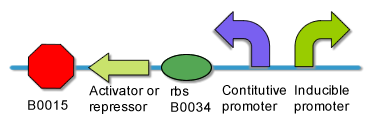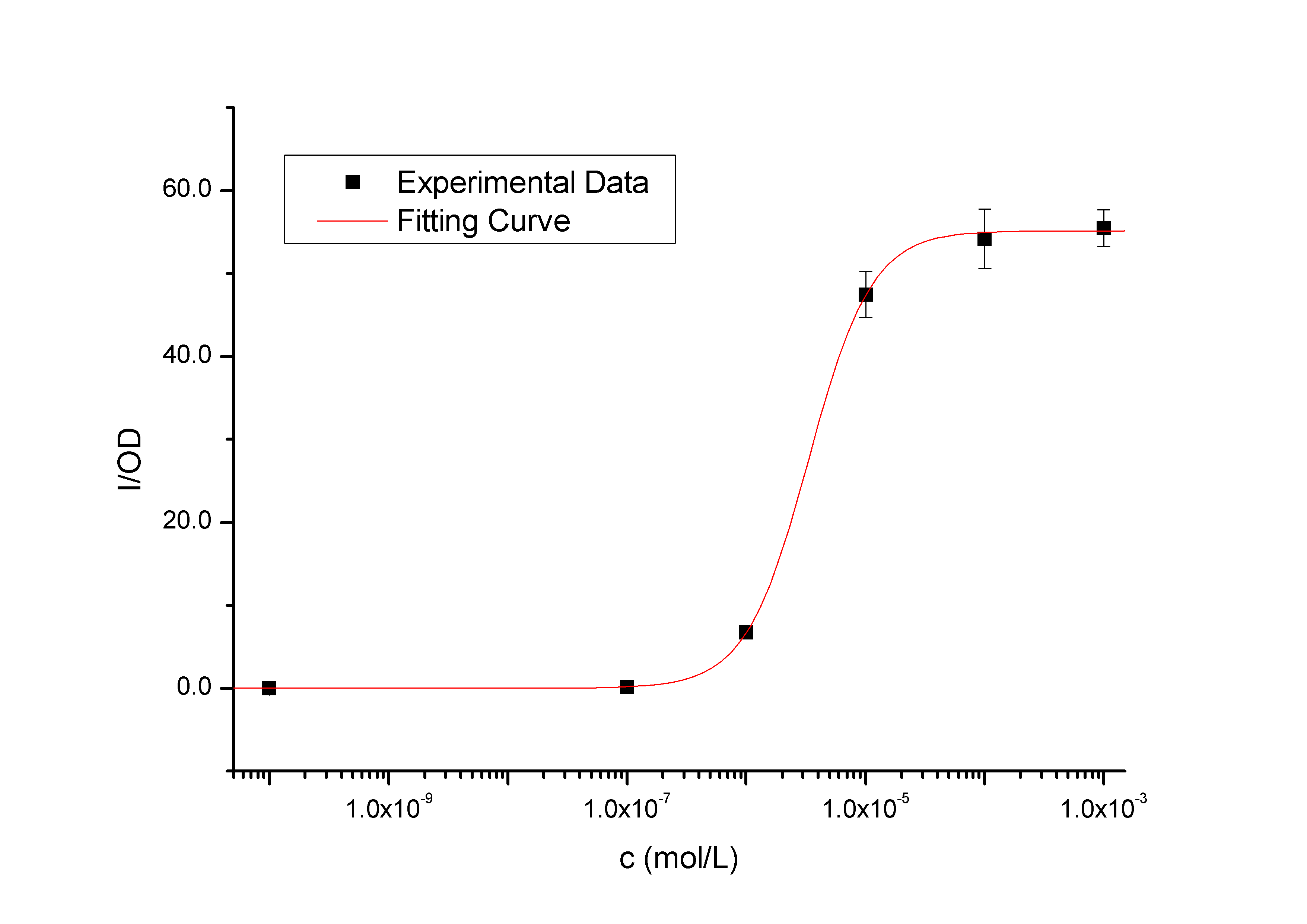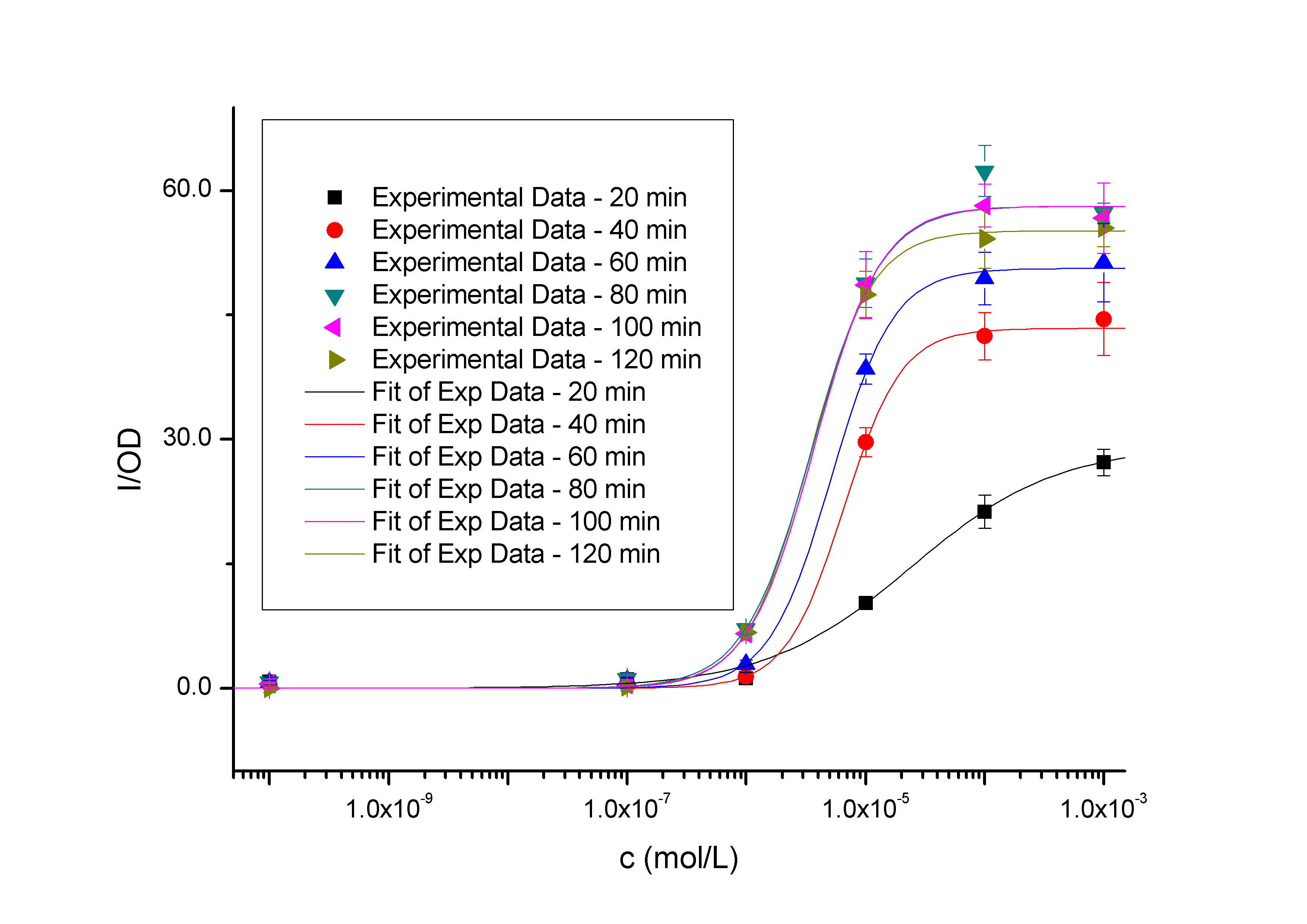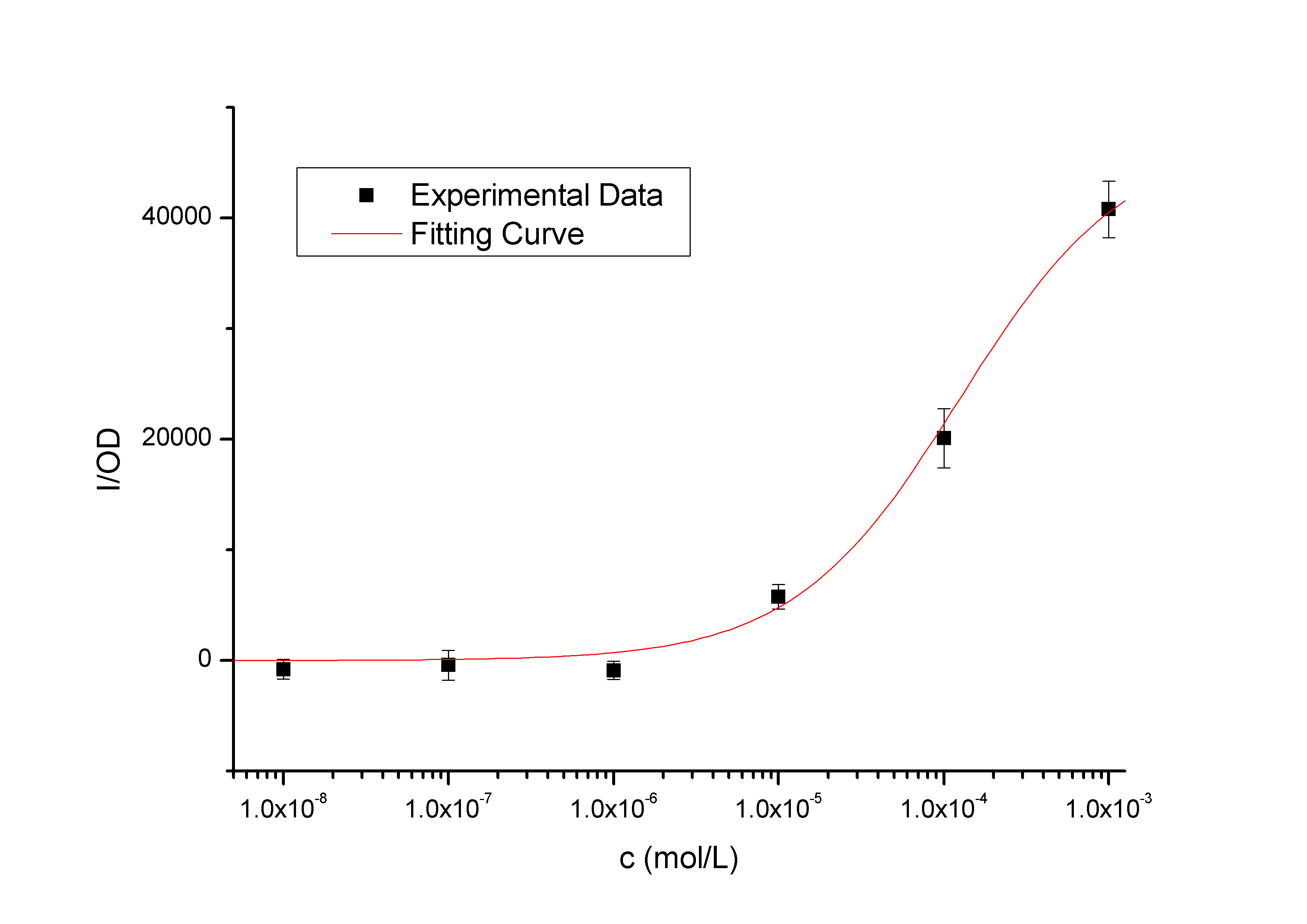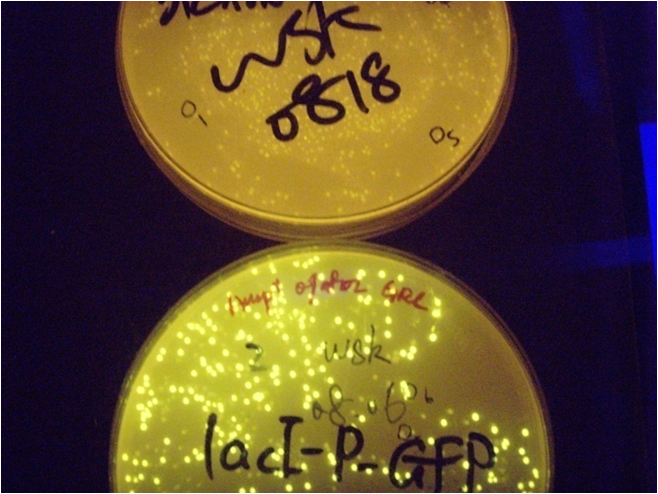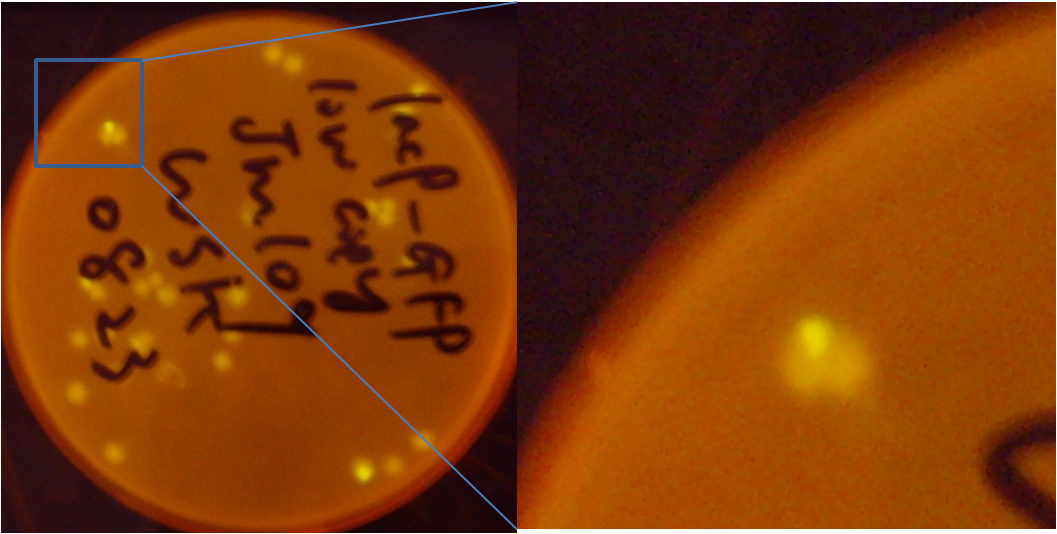Team:PKU Beijing/Project/AND Gate 1/Inducible System Result
From 2009.igem.org
| Line 27: | Line 27: | ||
==='''Salicylate Sensor'''=== | ==='''Salicylate Sensor'''=== | ||
| - | [[Image:PKU_BBa_K228004_120min.png|300px|right|thumb| | + | [[Image:PKU_BBa_K228004_120min.png|300px|right|thumb|Fig1 - Transfer function of BBa_K228004. This transfer function is the 120 min time-slice from the time and dose dependent input-output surface. The data points represent the mean of 6 individual measurements. The corresponding error bars represent the 95% confidence interval in the mean of the independent measurements. The solid black curve was calculated by fitting a simple Hill function to the experimental measurements. The Y axis denotes the value of fluorescence normalized by the OD600 value, and the X axis denotes the concentration of the inducer. ]] |
| Line 40: | Line 40: | ||
The transfer function in Figure 1 is the 120 min time-slice from the time and dose dependent surface. The data points represent the mean of 6 individual measurements. The corresponding error bars denote the 95% confidence interval in the mean of the independent measurements. In Figure 2, the level of induction triggered by the same concentration of inducer (of which concentrations are higher than 10^-7 mol/L, causing concentration of 10^-10 mol/L group has no significantly positive differences with the blank group) will be enhanced as the induction time extended, so it is the same with the saturation of fluorescence, as expected. | The transfer function in Figure 1 is the 120 min time-slice from the time and dose dependent surface. The data points represent the mean of 6 individual measurements. The corresponding error bars denote the 95% confidence interval in the mean of the independent measurements. In Figure 2, the level of induction triggered by the same concentration of inducer (of which concentrations are higher than 10^-7 mol/L, causing concentration of 10^-10 mol/L group has no significantly positive differences with the blank group) will be enhanced as the induction time extended, so it is the same with the saturation of fluorescence, as expected. | ||
| - | [[Image:PKU_BBa_K228004_All6_new.png|600px|center|thumb| | + | [[Image:PKU_BBa_K228004_All6_new.png|600px|center|thumb|Fig2 – Transfer functions of BBa_K228004 in different time slices from the time and dose dependent input-output surface. The data points represent the mean of 6 individual measurements. The corresponding error bars denoting the 95% confidence interval in the mean of the independent measurements. These solid curves were calculated by fitting simple Hill functions to the experimental measurements. The Y axis denotes the value of fluorescence normalized by the OD600 value, and the X axis denotes the concentration of the inducer. As we can see, the level of induction triggered by the same concentration of inducer (higher than 10^-7 mol/L, causing concentration of 10^-10 mol/L has no significantly positive differences with the blank) will be enhanced as the induction time being extended, so it is the same with the out-put saturation. ]] |
We used least squares estimation to fit a simple model to the data assuming that GFP is not degraded. Hill equations derived from simple biochemical equations describe the data well (Table 1). Pmax is the maximum output level, K is the switch point, and n is the hill coefficient describing the steepness of the transition from low output to high output. | We used least squares estimation to fit a simple model to the data assuming that GFP is not degraded. Hill equations derived from simple biochemical equations describe the data well (Table 1). Pmax is the maximum output level, K is the switch point, and n is the hill coefficient describing the steepness of the transition from low output to high output. | ||
| Line 67: | Line 67: | ||
The araC-pBad system: (Part: <partinfo>K228009</partinfo>) | The araC-pBad system: (Part: <partinfo>K228009</partinfo>) | ||
| - | [[Image:PKU_GRC_AraC_120min.png|300px|right|thumb| | + | [[Image:PKU_GRC_AraC_120min.png|300px|right|thumb|Fig3. Transfer function of arabinose sensor. This transfer function is a 120 min time-slice from the time and dose dependent input-output surface. Data points represent the mean of 6 individual measurements. The corresponding error bars represent the 95% confidence interval in the mean of the independent measurements. The Y axis denotes the value of fluorescence normalized by the OD600 value, and the X axis denotes the concentration of arabinose.]] |
We have constructed the inducement system composed of L-Arabinose inducible Pbad promoter and constitutively expressed AraC regulatory protein. When arabinose is absent, the AraC protein binds to and represses Pbad very efficiently. Thus, the transcription of any downstream coding gene is restricted. On the other hand, the import of arabinose could change the conformation of AraC protein, successfully prevent it repressing Pbad promoter and activate the transcription of downstream coding gene, such as GFP. | We have constructed the inducement system composed of L-Arabinose inducible Pbad promoter and constitutively expressed AraC regulatory protein. When arabinose is absent, the AraC protein binds to and represses Pbad very efficiently. Thus, the transcription of any downstream coding gene is restricted. On the other hand, the import of arabinose could change the conformation of AraC protein, successfully prevent it repressing Pbad promoter and activate the transcription of downstream coding gene, such as GFP. | ||
| Line 78: | Line 78: | ||
==='''aTc Sensor'''=== | ==='''aTc Sensor'''=== | ||
| - | [[Image:PKU_aTc sensor.png|300px|right|thumb| | + | [[Image:PKU_aTc sensor.png|300px|right|thumb| Fig4. the result of tet promoter system. <br>This is a picture of tet system, the colonies are green under blue light, even without induction, the upper plate is for comparison.]] |
The tetR-pTet system (parts: <partinfo>K228820</partinfo>)<br> | The tetR-pTet system (parts: <partinfo>K228820</partinfo>)<br> | ||
| Line 88: | Line 88: | ||
==='''IPTG Sensor'''=== | ==='''IPTG Sensor'''=== | ||
The lacI-pLac system (Part: <partinfo>K228819</partinfo>) | The lacI-pLac system (Part: <partinfo>K228819</partinfo>) | ||
| - | The result is similar to the tetR system. The colonies which contain the IPTG sensor - GFP plasmid expressed GFP even without induction, and the GFP flourescence didn't increase even after IPTG induction. The evidence that this construct is leaky without induction is on | + | The result is similar to the tetR system. The colonies which contain the IPTG sensor - GFP plasmid expressed GFP even without induction, and the GFP flourescence didn't increase even after IPTG induction. The evidence that this construct is leaky without induction is on Fig5, and the data after induction are not showed here. |
Nevertheless, we found another way to bypass the problem: take advantage of the lacIq on the F plasmid of ''E. coli'' strain [http://ecoliwiki.net/colipedia/index.php/JM109 JM109]. Since the F plasmid is one copy per cell, pLac (<partinfo>BBa_R0010</partinfo>) should be on a low copy plasmid, such as pSB4K5. The pLac can be repressed by endogenous lacI even without its represssor coexpressed on the same plasmid. Thus we constructed the simplified system (Part: <partinfo>K228821</partinfo>) and induced it by different concentration of IPTG. The result is shown in Fig3, judging from the induction curve, pLac promoter may be qualified in constructing the AND Gate. | Nevertheless, we found another way to bypass the problem: take advantage of the lacIq on the F plasmid of ''E. coli'' strain [http://ecoliwiki.net/colipedia/index.php/JM109 JM109]. Since the F plasmid is one copy per cell, pLac (<partinfo>BBa_R0010</partinfo>) should be on a low copy plasmid, such as pSB4K5. The pLac can be repressed by endogenous lacI even without its represssor coexpressed on the same plasmid. Thus we constructed the simplified system (Part: <partinfo>K228821</partinfo>) and induced it by different concentration of IPTG. The result is shown in Fig3, judging from the induction curve, pLac promoter may be qualified in constructing the AND Gate. | ||
| - | [[Image:PKU_lac_0.png|300px|left|thumb| | + | [[Image:PKU_lac_0.png|300px|left|thumb|Fig5. the result of pLac promoter system. The colonies are green under blue light, even without induction, the upper plate is for comparison.]] |
| - | [[Image:PKU_Lac_1.png|325px|left|thumb| | + | [[Image:PKU_Lac_1.png|325px|left|thumb|Fig6. lac promoter induction curve.<br>The Bacteria is induced with 10^-9~10^-3 M IPTG, the fluorescence is measured by plate-reader]] |
<br> | <br> | ||
| - | [[Image:PKU_lac_1.png|400px|left|thumb| | + | [[Image:PKU_lac_1.png|400px|left|thumb|Fig7. the JM109 colonies that contain low copy pLac-GFP plasmid. Center of the colonies turns green, while in the other area GFP expression is suppressed. It suggests that some E.coli lost their F plasmids]] |
<br> | <br> | ||
However, there is still another problem in this simplified system: the loss of F plasmid of JM109 may lead to activation of promoter pLac without induction. From the plate (without induction), we found that part(especially the central part) of a singal colony turned green, while they are supposed to stop express GFP in the presence of lacIq. A stronger evidence is the data from flowcytometry: The strength of GFP fluorescence obviously shows double peaks. All these suggest that some of the cell retains the F plasmid while the the others lost it. | However, there is still another problem in this simplified system: the loss of F plasmid of JM109 may lead to activation of promoter pLac without induction. From the plate (without induction), we found that part(especially the central part) of a singal colony turned green, while they are supposed to stop express GFP in the presence of lacIq. A stronger evidence is the data from flowcytometry: The strength of GFP fluorescence obviously shows double peaks. All these suggest that some of the cell retains the F plasmid while the the others lost it. | ||
| - | [[Image:PKU_lac_2.png|700px|center|thumb| | + | [[Image:PKU_lac_2.png|700px|center|thumb|Fig8a, b & c. The fluorescence was measured by flowcytometry to see the fluorescence of each cell in a population. <br>Fig5a illustrates that there are leaky cells and normal cells without induction. Fig4b shows the data from the cells induced by 10^-6M IPTG, and Fig4c show those induced by 10^-5M IPTG. Double peaks can be observed on both 8a and 8b, which means there are two groups of E.coli, but as the induction saturates, two peaks merge into one peak.]] |
In a word, the pLac promoter is not a perfect promoter to construct AND Gate. However, if a more stable source of lacI can be supplied, we believe it would be better. | In a word, the pLac promoter is not a perfect promoter to construct AND Gate. However, if a more stable source of lacI can be supplied, we believe it would be better. | ||
| Line 106: | Line 106: | ||
==='''HSL Sensor'''=== | ==='''HSL Sensor'''=== | ||
| - | [[Image:HSL_Sensor_Curve.png|300px|thumb| | + | [[Image:HSL_Sensor_Curve.png|300px|thumb|fig9. The Induction Curve of HSL Sensor]] |
<br> | <br> | ||
The luxR-luxP system (Parts: K228010, mainly by Min Lin) | The luxR-luxP system (Parts: K228010, mainly by Min Lin) | ||
| - | We have constructed the plasmid (based on the part:<partinfo>BBa_J09855</partinfo>, constructed by iGEM2006_Pennstate. ), and used different concentration of homoserine lactone to induce (See [https://2009.igem.org/Team:PKU_Beijing/Notebook/Protocol/Chemical_Inducible_GFP Protocols]). The fluorescence of individual cell is tested by flowcytometry. The result shows that this HSL Sensor can be induced to 8 fold with HSL(Fig | + | We have constructed the plasmid (based on the part:<partinfo>BBa_J09855</partinfo>, constructed by iGEM2006_Pennstate. ), and used different concentration of homoserine lactone to induce (See [https://2009.igem.org/Team:PKU_Beijing/Notebook/Protocol/Chemical_Inducible_GFP Protocols]). The fluorescence of individual cell is tested by flowcytometry. The result shows that this HSL Sensor can be induced to 8 fold with HSL(Fig 9). |
Although induction can be observed when HSL is added to the medium, the basal of this promoter is quite high. And it is later that we found this promoter is not qualified enough to construct our AND Gate(See the [[Team:PKU_Beijing/Project/AND_Gate_1/AND_Gate_Result|AND Gate 1 Result Section]]). | Although induction can be observed when HSL is added to the medium, the basal of this promoter is quite high. And it is later that we found this promoter is not qualified enough to construct our AND Gate(See the [[Team:PKU_Beijing/Project/AND_Gate_1/AND_Gate_Result|AND Gate 1 Result Section]]). | ||
Revision as of 16:58, 21 October 2009
|
||||||||||||||||||||||||||||||||||||||
|
||||||||||||||||||||||||||||||||||||||
 "
"

